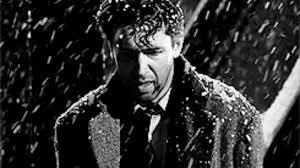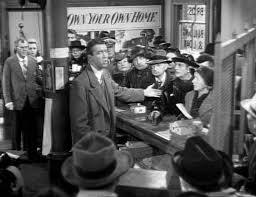My favorite Christmas movie #1: It's a Wonderful Life
The Morality of Banking in It’s a Wonderful Life
Excerpt:
Gillian B. White: I forgot how much commentary there is in this movie about the economics of how banks and loans work. I want an audio file of George Bailey saying “The money’s not there!” as he tries to explain how deposits get rolled into other products, not just stacks of bills tucked away in a vault. But I love that speech for another reason, too: It helps explain, at a pretty simple level, how deeply interwoven America’s banking structure and finances can be—so when a bank, big or small, fails, lots of people wind up feeling the impact. As a whole, the movie raises some critical questions about the purpose of banks: What are they meant to do and who are they meant to serve?
Bourree Lam: That scene has always really stuck out to me. It’s an important plot point, but I also think it speaks to how much people don’t know about how banks actually work. It’s really not clear to the people of Bedford Falls how credit and loans work, to the point that people cause a bank run and George has to use his own money to stop the institution from dissolving. They really think all their money is sitting there in the safe, but never question how the bank is then able to distribute so much money, such as loans for their homes.How Jimmy Stewart Became George Bailey - The star of ‘It’s a Wonderful Life’ struggled with his wartime memories
Excerpt:
Fans of the movie might assume that making such an uplifting tale was a joy for cast and crew. In truth, this story of redeeming angels was born in the devastating wake of World War II, and it starred an actor swatting away his own demons.
The first time that Jimmy Stewart appears on screen as George Bailey, the image freezes in close-up as two angelic figures discuss the character in voice-over. One says to the other, “I want you to take a good look at that face.” It’s something that all of us should do as we watch the film.
Stewart is supposed to be playing a young man in his early 20s, but the once-boyish 38-year-old had just returned the year before from fighting in Europe, and only makeup and careful lighting could give him a semblance of youth. More seriously, as we know from the testimony of those who worked with him in the military and in Hollywood in those years, Stewart was suffering from what we now call post-traumatic stress disorder.Why I like it: There's been times in my life that I've felt I've screwed up so much that my life is less than useless ... I remember (this is about 3 decades ago) when I felt that if I were dead (I had life insurance then) that my wife would be better off. How I view it today: This is my "you've got cancer" year and this year I am trying to focus on the wonderful gift of life! Today is "the present" and today is a gift of God. The first article has some nice YouTube videos embedded. Here is the famous dance scene:
More from the Economist: Why “It’s a Wonderful Life” needed an angel’s helping hand
IN THE late summer of 1945, Colonel James Stewart returned from Europe aboard the Queen Elizabeth; like the hundreds of other men aboard, Stewart wondered what post-war life might hold. His contemporary John Wayne had avoided service in the second world war, but since his enlistment in 1941 Stewart had risen from the rank of private, flying 20 combat missions over Nazi-occupied Europe: he re-entered civilian life as a decorated hero. The year before Pearl Harbour, he had won an Oscar for Best Actor for his role as a tabloid reporter in George Cukor’s “The Philadelphia Story”—but his contract with MGM had expired during the war.
“I just got a phone call one day,” Stewart said years later of this uncertain time. “It was Frank Capra, and he said, I’ve got an idea for a story, why don’t you come down and I’ll tell it to you. Well, I couldn’t get down there quick enough,” Stewart recalled.
“It’s a Wonderful Life” was released seventy years ago, in December, 1946. The Sicilian-born Capra had also served America's army, winning the Distinguished Service Medal for his documentary series, “Why We Fight”. Director and star had worked together before the war on “You Can’t Take It With You” (1938) and “Mr Smith Goes to Washington” (1939), but it is “It’s a Wonderful Life”, the story of George Bailey, his guardian angel Clarence, and the fate of the little town of Bedford Falls which epitomises their partnership. “It shows values that are really very close to an awful lot of us, and are really very basic American values,” Stewart would say decades later.
In the 21st century it can be hard to talk of “American values” with a straight face; but even at the time critics recognised that Capra’s film—much darker than it’s often remembered to be, as full of shadow as it is of light—worked a kind of alchemy of emotion. Capra “again proves he can fashion what ordinarily would be homilising hokum into gleaming, engaging entertainment for all brows—high, low or beetle,” wrote Variety when the film appeared. The Hollywood Reporter echoed the praise. But the box office was not as kind as the reviews, and the film was by no means a hit; it was only when, thanks to what was essentially a clerical error, the film temporarily fell out of copyright in 1974 that it became the cast-iron Christmas classic it is today. It was picked up by American television networks eager for holiday fodder, and it has never been off the airwaves since.













JP, as they say in that famous poem, "Twas the night before Christmas": Happy Christmas to all!
ReplyDeleteJP, I hope you don't plan on shopping at Nordstrom's, the department store. That store is not longer in existence and they changed their name to Nordstrom. When did they do this?
ReplyDeleteJP, why did this famous "twas the night before Christmas" change from "Merry Christmas" at the end to "Happy Christmas"? Happy Christmas? Are you kidding? Who says that? And why did Bing Crosby change the 12 days of Christmas to "my true love SENT to me"? And how did he change his song after his death? And why did Nordstrom's change their name to Nordstrom? Pretty weird if you ask me.
ReplyDeleteDon't forget Peanuts. This is a well known Christmas show and the music from the show is still widely played. So why did Peanuts creater Charles M. Shultz recently change his name from Charles M. Shultz to Charles M. Shulz? He's another fellow who changed stuff in his body of work - after his death. This is too creepy. Is this what they mean when people talk about "the war on Christmas?"
ReplyDelete